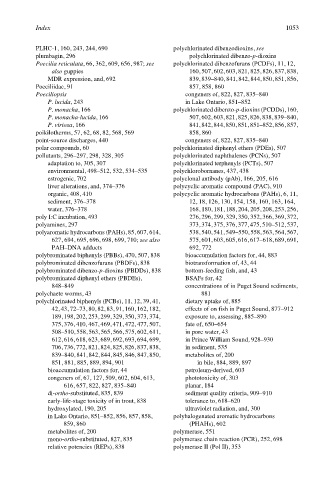Page 1073 - The Toxicology of Fishes
P. 1073
Index 1053
PLHC-1, 160, 243, 244, 690 polychlorinated dibenzodioxins, see
plumbagin, 296 polychlorinated dibenzo-p-dioxins
Poecilia reticulata, 66, 362, 609, 656, 987; see polychlorinated dibenzofurans (PCDFs), 11, 12,
also guppies 160, 507, 602, 603, 821, 825, 826, 837, 838,
MDR expression, and, 692 839, 839–840, 841, 842, 844, 850, 851, 856,
Poeciliidae, 91 857, 858, 860
Poeciliopsis congeners of, 822, 827, 835–840
P. lucida, 243 in Lake Ontario, 851–852
P. monacha, 166 polychlorinated dibenzo-p-dioxins (PCDDs), 160,
P. monacha-lucida, 166 507, 602, 603, 821, 825, 826, 838, 839–840,
P. viriosa, 166 841, 842, 844, 850, 851, 851–852, 856, 857,
poikilotherms, 57, 62, 68, 82, 568, 569 858, 860
point-source discharges, 440 congeners of, 822, 827, 835–840
polar compounds, 60 polychlorinated diphenyl ethers (PDEs), 507
pollutants, 296–297, 298, 328, 305 polychlorinated naphthalenes (PCNs), 507
adaptation to, 305, 307 polychlorinated terphenyls (PCTs), 507
environmental, 498–512, 532, 534–535 polychlorobornanes, 437, 438
estrogenic, 702 polyclonal antibody (pAb), 166, 205, 616
liver alterations, and, 374–376 polycyclic aromatic compound (PAC), 910
organic, 408, 410 polycyclic aromatic hydrocarbons (PAHs), 6, 11,
sediment, 376–378 12, 18, 126, 130, 154, 158, 160, 163, 164,
water, 376–378 168, 180, 181, 188, 204, 205, 208, 253, 256,
poly I:C incubation, 493 276, 296, 299, 329, 350, 352, 366, 369, 372,
polyamines, 297 373, 374, 375, 376, 377, 475, 510–512, 537,
polyaromatic hydrocarbons (PAHs), 85, 607, 614, 538, 540, 541, 549–550, 558, 563, 564, 567,
627, 694, 695, 696, 698, 699, 710; see also 575, 601, 603, 605, 616, 617–618, 689, 691,
PAH–DNA adducts 692, 772
polybrominated biphenyls (PBBs), 470, 507, 838 bioaccumulation factors for, 44, 883
polybrominated dibenzofurans (PBDFs), 838 biotransformation of, 43, 44
polybrominated dibenzo-p-dioxins (PBDDs), 838 bottom-feeding fish, and, 43
polybrominated diphenyl ethers (PBDEs), BSAFs for, 42
848–849 concentrations of in Puget Sound sediments,
polychaete worms, 43 881
polychlorinated biphenyls (PCBs), 11, 12, 39, 41, dietary uptake of, 885
42, 43, 72–73, 80, 82, 83, 91, 160, 162, 182, effects of on fish in Puget Sound, 877–912
189, 198, 202, 253, 299, 329, 350, 373, 374, exposure to, assessing, 885–890
375, 376, 410, 467, 469, 471, 472, 477, 507, fate of, 650–654
508–510, 558, 563, 565, 566, 575, 602, 611, in pore water, 43
612, 616, 618, 623, 689, 692, 693, 694, 699, in Prince William Sound, 928–930
706, 736, 772, 821, 824, 825, 826, 837, 838, in sediment, 535
839–840, 841, 842, 844, 845, 846, 847, 850, metabolites of, 200
851, 881, 885, 889, 894, 901 in bile, 884, 889, 897
bioaccumulation factors for, 44 petroleum-derived, 603
congeners of, 67, 127, 509, 602, 604, 613, phototoxicity of, 303
616, 657, 822, 827, 835–840 planar, 184
di-ortho-substituted, 835, 839 sediment quality criteria, 909–910
early-life-stage toxicity of in trout, 838 tolerance to, 618–620
hydroxylated, 190, 205 ultraviolet radiation, and, 300
in Lake Ontario, 851–852, 856, 857, 858, polyhalogenated aromatic hydrocarbons
859, 860 (PHAHs), 602
metabolites of, 200 polymerase, 551
mono-ortho-substituted, 827, 835 polymerase chain reaction (PCR), 252, 698
relative potencies (REPs), 838 polymerase II (Pol II), 353

